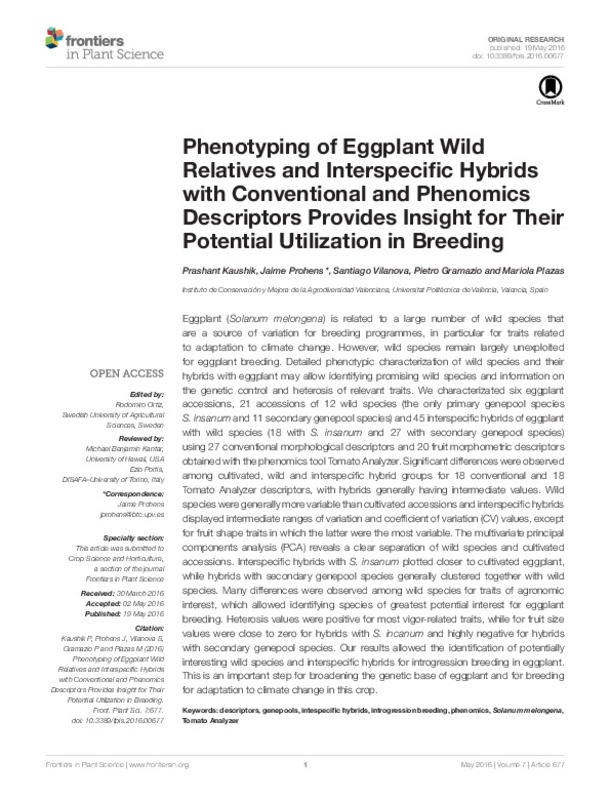JavaScript is disabled for your browser. Some features of this site may not work without it.
Buscar en RiuNet
Listar
Mi cuenta
Estadísticas
Ayuda RiuNet
Admin. UPV
Phenotyping of Eggplant Wild Relatives and Interspecific Hybrids with Conventional and Phenomics Descriptors Provides Insight for Their Potential Utilization in Breeding
Mostrar el registro sencillo del ítem
Ficheros en el ítem
| dc.contributor.author | Kaushik, Prashant
|
es_ES |
| dc.contributor.author | Prohens Tomás, Jaime
|
es_ES |
| dc.contributor.author | Vilanova Navarro, Santiago
|
es_ES |
| dc.contributor.author | Gramazio, Pietro
|
es_ES |
| dc.contributor.author | Plazas Ávila, María de la O
|
es_ES |
| dc.date.accessioned | 2018-10-18T04:30:42Z | |
| dc.date.available | 2018-10-18T04:30:42Z | |
| dc.date.issued | 2016 | es_ES |
| dc.identifier.uri | http://hdl.handle.net/10251/110822 | |
| dc.description.abstract | [EN] Eggplant (Solanum melongena) is related to a large number of wild species that are a source of variation for breeding programmes, in particular for traits related to adaptation to climate change. However, wild species remain largely unexploited for eggplant breeding. Detailed phenotypic characterization of wild species and their hybrids with eggplant may allow identifying promising wild species and information on the genetic control and heterosis of relevant traits. We characterizated six eggplant accessions, 21 accessions of 12 wild species (the only primary genepool species S. insanum and 11 secondary genepool species) and 45 interspecific hybrids of eggplant ith wild species (18 with S. insanum and 27 with secondary genepool species) using 27 conventional morphological descriptors and 20 fruit morphometric descriptors obtained with the phenomics tool Tomato Analyzer. Significant differences were observed among cultivated, wild and interspecific hybrid groups for 18 conventional and 18 Tomato Analyzer descriptors, with hybrids generally having intermediate values. Wild species were generally more variable than cultivated accessions and interspecific hybrids displayed intermediate ranges of variation and coefficient of variation (CV) values, except for fruit shape traits in which the latter were the most variable. The multivariate principal components analysis (PCA) reveals a clear separation of wild species and cultivated accessions. Interspecific hybrids with S. insanum plotted closer to cultivated eggplant, while hybrids with secondary genepool species generally clustered together with wild species. Many differences were observed among wild species for traits of agronomic interest, which allowed identifying species of greatest potential interest for eggplant breeding. Heterosis values were positive for most vigor-related traits, while for fruit size values were close to zero for hybrids with S. incanum and highly negative for hybrids with secondary genepool species. Our results allowed the identification of potentially interesting wild species and interspecific hybrids for introgression breeding in eggplant. This is an important step for broadening the genetic base of eggplant and for breeding for adaptation to climate change in this crop. | es_ES |
| dc.description.sponsorship | The present work was financially supported by CONICET Argentina, UNLP, and ANPCyT (Project PICT 2011-1213) | |
| dc.language | Inglés | es_ES |
| dc.publisher | Frontiers Media SA | es_ES |
| dc.relation.ispartof | Frontiers in Plant Science | es_ES |
| dc.rights | Reserva de todos los derechos | es_ES |
| dc.subject | Descriptors | es_ES |
| dc.subject | Genepools | es_ES |
| dc.subject | Intespecific hybrids | es_ES |
| dc.subject | Introgression breeding | es_ES |
| dc.subject | Phenomics | es_ES |
| dc.subject | Solanum melongena | es_ES |
| dc.subject | Tomato Analyzer | es_ES |
| dc.subject.classification | GENETICA | es_ES |
| dc.title | Phenotyping of Eggplant Wild Relatives and Interspecific Hybrids with Conventional and Phenomics Descriptors Provides Insight for Their Potential Utilization in Breeding | es_ES |
| dc.type | Artículo | es_ES |
| dc.identifier.doi | 10.3389/fpls.2016.00677 | es_ES |
| dc.relation.projectID | info:eu-repo/grantAgreement/EC/H2020/677379/EU/Linking genetic resources, genomes and phenotypes of Solanaceous crops/ | es_ES |
| dc.relation.projectID | info:eu-repo/grantAgreement/MINECO//AGL2015-64755-R/ES/MEJORA GENETICA DE LA CALIDAD FUNCIONAL Y APARENTE DE LA BERENJENA/ | es_ES |
| dc.relation.projectID | info:eu-repo/grantAgreement/UPV//FPI%2F1%2F2013/ | |
| dc.rights.accessRights | Abierto | es_ES |
| dc.contributor.affiliation | Universitat Politècnica de València. Instituto Universitario de Conservación y Mejora de la Agrodiversidad Valenciana - Institut Universitari de Conservació i Millora de l'Agrodiversitat Valenciana | es_ES |
| dc.contributor.affiliation | Universitat Politècnica de València. Departamento de Biotecnología - Departament de Biotecnologia | es_ES |
| dc.description.bibliographicCitation | Kaushik, P.; Prohens Tomás, J.; Vilanova Navarro, S.; Gramazio, P.; Plazas Ávila, MDLO. (2016). Phenotyping of Eggplant Wild Relatives and Interspecific Hybrids with Conventional and Phenomics Descriptors Provides Insight for Their Potential Utilization in Breeding. Frontiers in Plant Science. 7. https://doi.org/10.3389/fpls.2016.00677 | es_ES |
| dc.description.accrualMethod | S | es_ES |
| dc.relation.publisherversion | http://doi.org/10.3389/fpls.2016.00677 | es_ES |
| dc.type.version | info:eu-repo/semantics/publishedVersion | es_ES |
| dc.description.volume | 7 | es_ES |
| dc.identifier.eissn | 1664-462X | es_ES |
| dc.identifier.pmid | 27242876 | en_EN |
| dc.identifier.pmcid | PMC4871888 | en_EN |
| dc.relation.pasarela | S\315636 | es_ES |
| dc.contributor.funder | European Commission | es_ES |
| dc.contributor.funder | Ministerio de Economía, Industria y Competitividad | es_ES |
| dc.contributor.funder | Universitat Politècnica de València |








